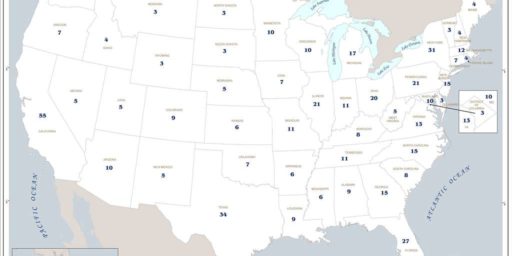Comparative Electoral Systems Basics
Some context for ongoing discussions.
 To provide some context to my post regards bipartism in the United States, let me provide some comparative context, starting with this table (5.2) from A Different Democracy:
To provide some context to my post regards bipartism in the United States, let me provide some comparative context, starting with this table (5.2) from A Different Democracy:

Note that the table excludes mixed-member systems that combine elements of the top left and bottom right quadrants, such as Mixed-Member Plurality (MMP) in Germany and NZ and Mixed-Member Majoritarian (MMM) in Hungary, Korea, Japan, Mexico and Italy.
In the candidate-centric, single-seat quadrant, we have the system the US uses along with a couple other cases, including variants on the system to include France’s peculiar two-round system* and the alternative vote in Australia. The quadrant below has cases of systems wherein voters vote for candidates, not parties in multi-seat districts, one of which is not especially proportional, the Single Non-Transferable Vote and the proportional Single Transferable Vote (which is essentially ranked choice voting in a multi-seat district). The bottom right lists systems in which voters cast their votes for party list (even though in some cases they can also mark candidate preferences, the votes still all accrue to the party).
In party list systems the voter votes for a party and that party accumulates votes to determine how many seats it will get from a list of its candidates. In list systems voter sometimes has the option to vote for a preferred candidate within the party (open list systems). Systems in which the voter cannot indicate candidates preferences is called a closed list system. Seats, however, are allocated on the vote the party wins. Since these are all multi-seat districts, a list of candidates has to be provided.
A simple example that I have handy is this ballot from Colombia for the Andean Parliament election in 2010:
The voter selects the preferred party by marking the symbol. The seats are awarded based on the votes each list gets. One list might get three seats and another two or some other allocation. Some of these lists are open (like the UP list) meaning voters could vote for which member of the list they preferred, while others are closed (like the Polo list) and therefore party leaders ranked their candidates. If the Polo list won three seats, then the top three on their list would be seated. If the UP list won one seat, the winner would be the one who earned the most preference votes. The UP would win votes if a voter voted for the party but did not want to register a preference.
Party list systems are proportional by nature (although exactly how proportional varies by system due to multiple factors). This encourages multi-party systems because parties can win seats with small vote totals. An extreme example of such a system is Israel, which will have elections next month. They elect the entire 120-seat Knesset in one multi-member district (so M, or district magnitude, equals 120). Typically the larger the M, the more proportional the system, although factors like allocation rules (Israel uses the D’Hondt method) and whether or not a legal threshold is in place, among other factors, can also influence how proportional the system is.
Since a party can win a seat with a low percentage of the vote, PR systems encourage multiple parties.
Mixed-member systems election some members of the legislature in single-seat districts and others from party lists. MMP systems produce a proportional outcome while MMM systems favor larger parties and not proportional.
Each type of system would require its own post, or set of posts, but this at least illustrates some of the variables that exist in elections. More at some point, I suspect (shameless plug: there are extensive explanations of these systems in our book).
Some info on some of the alphabet soup:
A great video primer on MMP can be found here.
A passable intro to SNTV can be found here (I think it overstates how proportional it is, plus does not get into nomination errors by parties–long story).
A video explainer for STV here and another with more detailed examples here.
Fairvote also has its Proportional Representation Library.
—
*In the French system any candidate who wins 12.5% of the vote move on the second round, which is determined by plurality.







OT: Brexit. Nigel Farage and his Brexit march started today. (The screen is a LedByDonkeys hack. LedByDonkeys is an anti-Brexit protest group that quotes all the promises the Brexit leaders made back at them.)
By the way, Nigel isn’t planning to march the whole way down to London. Just the beginning bit and the end bit, where all the cameramen are to be expected. The actual hard slog of 270 miles is to be done by other people. Oh, and that “vote showing 1.7 million supporters”? Roughly 70 of them showed up today.
(If this isn’t the best metaphor for Brexit EVAH.)
“Party list systems are proportional by nature ”
Not necessarily – you can have a party list system where the list with more votes receives all the seats: the real world case more similar to that is perhaps the US electoral college.
I think that Portugal, between 1933 and 1974 has a system like that (and with only one national circle) – but being in practice an one-party dictatorship, the details of the electoral system were largely irrelevant; but I think that even today the national council of the portuguese communist-led trade union confederation (the CGTP) is elected this way (the winning list elects all seats of the national council – but again, usually there is only one list); and the Greco-Italian electoral system, of bonus seats for the biggest party, can be considered a mix of this and PR.
@Miguel Madeira: How about: they tend to be. One can certainly think of possible deviations.